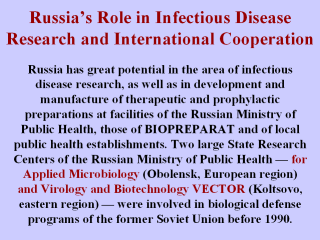| front |1 |2 |3 |4 |5 |6 |7 |8 |9 |10 |11 |12 |13 |14 |15 |16 |17 |18 |19 |20 |21 |22 |23 |24 |25 |26 |27 |28 |29 |30 |31 |32 |33 |34 |35 |36 |37 |38 |39 |40 |41 |42 |review |
 |
Consequently they have years of experience in
bacterial and viral pathogen research. With their technical and staff
capabilities they could play a significant role within a global network for
infectious diseases control. VECTOR fully follows the Russian guidelines and
forwards annual reports to the Committee on the Biological and Chemical
Weapons Conventions compliance at the office of the Russian president. These
reports are the documents that are envisaged by the Review Conference of the
1972 BW Convention for subsequent submission to the UN. Through the Russian Ministry of Science and Technologies, the Russian Ministry of Public Health and RAO "BIOPREPARAT", both the Obolensk and Koltsovo Centers are actively involved in broad international collaborations. These collaborations are under such organizations as International Science and Technology Center (ISTC, EC+USA+Japan), US National Academy of Sciences (NAS), Association for the Promotion of Cooperation with Scientists from New Independent States of the FSU (INTAS, EC), Civilian Research and Development Foundation (CRDF, USA), Initiatives for Proliferation Prevention (IPP-DOE, USA), National Aeronautics and Space Administration (NASA, USA), Defense Advanced Research Projects Agency (DARPA, USA). These international collaborations are aimed at nonproliferation and threat reduction by strengthening the confidence building measures and transparency, but do not involve dual use technologies. In 1997 an expert group of the US National Academy of Sciences (NAS) under the leadership of Prof. Joshua Lederberg and Dr. John Steinbruner, with the involvement of Russian experts, developed a concept for international collaboration in dangerous pathogen research [9]. This concept uses confidence building measures and transparency extensively. In particular, each project would have freedom of access at the place of performance and all results are to be provided to all counterparts. Collaborative work between Russian and US scientists would be carried out in laboratories of these countries under a separate agreement. This freedom of access is also defined in programs such as CRDF, NASA, DARPA and IPP (DOE). |